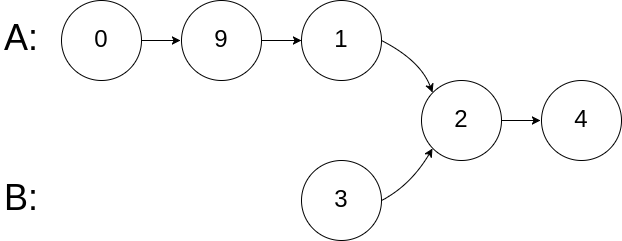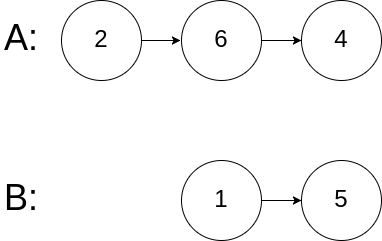mirror of
https://github.com/halfrost/LeetCode-Go.git
synced 2025-07-28 22:51:54 +08:00
116 lines
3.2 KiB
Markdown
116 lines
3.2 KiB
Markdown
# [160. Intersection of Two Linked Lists](https://leetcode.com/problems/intersection-of-two-linked-lists/)
|
|
|
|
## 题目
|
|
|
|
Write a program to find the node at which the intersection of two singly linked lists begins.
|
|
|
|
For example, the following two linked lists:
|
|
|
|

|
|
|
|
begin to intersect at node c1.
|
|
|
|
**Example 1**:
|
|
|
|

|
|
|
|
```
|
|
|
|
Input: intersectVal = 8, listA = [4,1,8,4,5], listB = [5,0,1,8,4,5], skipA = 2, skipB = 3
|
|
Output: Reference of the node with value = 8
|
|
Input Explanation: The intersected node's value is 8 (note that this must not be 0 if the two lists intersect). From the head of A, it reads as [4,1,8,4,5]. From the head of B, it reads as [5,0,1,8,4,5]. There are 2 nodes before the intersected node in A; There are 3 nodes before the intersected node in B.
|
|
|
|
```
|
|
|
|
**Example 2**:
|
|
|
|

|
|
|
|
```
|
|
|
|
Input: intersectVal = 2, listA = [0,9,1,2,4], listB = [3,2,4], skipA = 3, skipB = 1
|
|
Output: Reference of the node with value = 2
|
|
Input Explanation: The intersected node's value is 2 (note that this must not be 0 if the two lists intersect). From the head of A, it reads as [0,9,1,2,4]. From the head of B, it reads as [3,2,4]. There are 3 nodes before the intersected node in A; There are 1 node before the intersected node in B.
|
|
|
|
```
|
|
|
|
|
|
**Example 3**:
|
|
|
|

|
|
|
|
```
|
|
|
|
Input: intersectVal = 0, listA = [2,6,4], listB = [1,5], skipA = 3, skipB = 2
|
|
Output: null
|
|
Input Explanation: From the head of A, it reads as [2,6,4]. From the head of B, it reads as [1,5]. Since the two lists do not intersect, intersectVal must be 0, while skipA and skipB can be arbitrary values.
|
|
Explanation: The two lists do not intersect, so return null.
|
|
|
|
```
|
|
|
|
**Notes**:
|
|
|
|
- If the two linked lists have no intersection at all, return null.
|
|
- The linked lists must retain their original structure after the function returns.
|
|
- You may assume there are no cycles anywhere in the entire linked structure.
|
|
- Your code should preferably run in O(n) time and use only O(1) memory.
|
|
|
|
## 题目大意
|
|
|
|
找到 2 个链表的交叉点。
|
|
|
|
|
|
## 解题思路
|
|
|
|
这道题的思路其实类似链表找环。
|
|
|
|
|
|
给定的 2 个链表的长度如果一样长,都从头往后扫即可。如果不一样长,需要先“拼成”一样长。把 B 拼接到 A 后面,把 A 拼接到 B 后面。这样 2 个链表的长度都是 A + B。再依次扫描比较 2 个链表的结点是否相同。
|
|
|
|
|
|
|
|
|
|
## 代码
|
|
|
|
```go
|
|
|
|
package leetcode
|
|
|
|
import "fmt"
|
|
|
|
/**
|
|
* Definition for singly-linked list.
|
|
* type ListNode struct {
|
|
* Val int
|
|
* Next *ListNode
|
|
* }
|
|
*/
|
|
func getIntersectionNode(headA, headB *ListNode) *ListNode {
|
|
//boundary check
|
|
if headA == nil || headB == nil {
|
|
return nil
|
|
}
|
|
|
|
a := headA
|
|
b := headB
|
|
|
|
//if a & b have different len, then we will stop the loop after second iteration
|
|
for a != b {
|
|
//for the end of first iteration, we just reset the pointer to the head of another linkedlist
|
|
if a == nil {
|
|
a = headB
|
|
} else {
|
|
a = a.Next
|
|
}
|
|
|
|
if b == nil {
|
|
b = headA
|
|
} else {
|
|
b = b.Next
|
|
}
|
|
fmt.Printf("a = %v b = %v\n", a, b)
|
|
}
|
|
return a
|
|
}
|
|
|
|
``` |